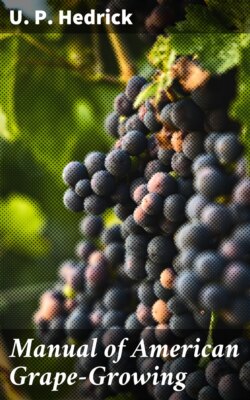Читать книгу Manual of American Grape-Growing - U. P. Hedrick - Страница 97
На сайте Литреса книга снята с продажи.
The operation of planting.
ОглавлениеAll being in readiness, planting proceeds rapidly. A gang of four men work to advantage. Two dig holes, a third holds the vines and tramps the earth as the remaining man shovels in earth. Except in large vineyards, four men are seldom available, and gangs of two or three must divide the work among its members as best suits conditions. A tree-setting board is not needed in planting grapes, although some growers use it. The man who holds the vines in the hole and tramps as the shoveler fills, must align the plant after the stake is removed and see that it stands perpendicularly in the hole. The stake, a lath, is set in its old place in the hole to serve as a support for the growing vine and to mark it so that the cultivator does not pull up the young plant. The soil must be set firm about the roots of the plant, but zeal in tramping should diminish as the hole is filled, leaving the topsoil untramped, smooth, loose and pulverized, a dust mulch—the best of all mulches—to prevent evaporation.
The depth to which vines should be set is a matter of controversy. This should be governed by the soil more than by any other factor, although some varieties need a deeper root-run than others. The rule to plant to the depth the vine stood in the nursery row is safe under most conditions, although in light, hungry or thirsty soils the roots should go deeper; and, on the other hand, in heavy soils, not so deep. Deep planting is a more common mistake than shallow planting, for roots under most conditions stand exposure better than internment, going down being more natural than coming up for a root seeking a place to its liking.
Watering at planting is necessary only when the land is parched with drought or in regions in which irrigation is practiced. When necessary, water should be used liberally, at least a gallon or two to a vine. After the earth has been firmed about the roots and the hole is nearly filled, the water should be poured in and the hole filled without more firming. Under dry weather conditions, some prefer to puddle the roots; that is, to dip them in thin mud and plant with the mud adhering. In making the puddle, loose loam and not sticky clay is used, as clay may bake so hard as to injure the roots. With puddling, as with watering, the surface soil should be left loose and soft without traces of the puddling below.
Manure or fertilizer about the roots or even in the hole are not necessary or even desirable. If the soil is to be enriched at all at planting time, the fertilizer should be spread on the surface to be cultivated in or to have its food elements leak down as rains fall. In land in which the providential design for grapes is plainly manifested, the vine at no time responds heartily to fertilizers, the good of stable manure probably coming for the most part from its effects on the texture and water-holding capacity of the soil. The newly set plant is not in need of outside nourishment; to put rank manure or strong commercial fertilizers about the roots of a young newly set vine is plant infanticide.
